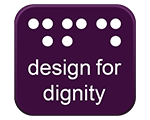Design For Dignity
Retail Guidelines




The ABS measured access to computers and internet for people with disability in 2012. It shows that 85.3 percent of people with disability aged between 15 and 64 living in households had access to a computer, and that 84 percent had access to the internet at home. In the 12 months before the survey, 75 percent had accessed the internet at home and 39.6 percent had accessed the internet away from home.
It is common for people with disability to use the internet with the assistance of specialised hardware or software. Increasingly, the in-built features of the device being used (like smartphones) enables interaction with a website. Some technologies that people will use to read, understand and use your website will include:
In the 2012 and 2013 Australian Network on Disability surveys into the accessibility of shopping experiences and telecommunications companies, people with disability provided the following information about website accessibility and features that they found difficult. In essence, simpler was better. Accessibility for screen reading software and assistive technology was essential.
“Having spent [a] long time looking for info, it's annoying and limiting to have to ring and can be hard to approach doing on multiple occasions.”
“The site is difficult to use. It is hard to find information, and it times out too soon.”
“The simpler the format the more comfortable it is for my vision to cope with.”
“Was frustrating as I couldn't do what I needed in a reasonable amount of time.”
“Make the online site very accessible, and easy and quick to use. Shopping from home is infinitely easier and less stressful than going into a store, but it always takes me hours to navigate the online site and choose what I want, so it's still ultimately quicker to go to the local shop.”
“Some portions of internet sites are compatible with voice activated software, but not all parts are. This makes me feel angry and marginalised.”
“I have only visited the site once due to the pop-ups disturbing my vision. Also I frequently have problems signing in with my password — for some reason it is not always accepted.”
“They often have advertisements playing when you first log in which means you can't hear what the screen reader is telling you — all you hear is the ad. You have to wait for the ad to finish before you can read through the page.”
“Create and maintain an accessible website, decrease delivery costs and increase availability of delivery times, especially during weekends.”
“Improve the online accessibility of the website as it assists multiple audiences with disability. For me this is the number one priority.”
“Ensure ‘all’ components/sections of their online shopping website are easily navigable/accessible for vision impaired persons using screen-reading technology.”